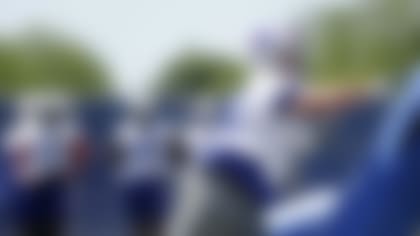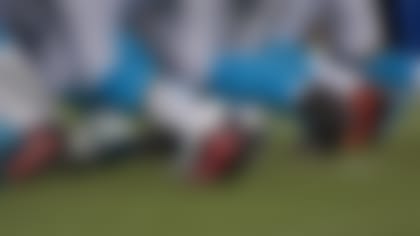The NFL released its most recent preseason injury data on October 16, 2018 during the Fall League Meeting in New York. The injury data is compiled and analyzed by IQVIA (formerly Quintiles), an independent third-party company retained by the NFL. For more information, see the injury data page.
NFL CHIEF MEDICAL OFFICER DR. ALLEN SILLS AND NFL EXECUTIVE VICE PRESIDENT OF PLAYER HEALTH AND SAFETY JEFF MILLER: GAGGLE WITH MEDIA
2018 FALL LEAGUE MEETING – NEW YORK, NY (OCTOBER 16, 2018)
Jeff Miller: … around the rule changes that were made, we worked with the Competition Committee—that's the use of the helmet rule and the kickoff—on both of those plays identifying particular behaviors for rules where there were opportunities to decrease the amount of injury. For example, on kickoffs, there was a four times incidence of concussions over a regular play. So, we continue to collect all of this information and share it when we can and when we are confident in it, which is not all the time. We are very careful because numbers change and the analysis changes. We want to understand exactly what we are presenting before we do it. Concussions were down in the preseason, from 91 a year ago down to 79, which is 13%, or 13.18% to be precise. Allen can give you a breakdown on that and the helmet stuff too.
Dr. Allen Sills: As Jeff said, concussions were down in the preseason, from 91 in 2017 to 79 in 2018. We are cautiously optimistic about that result. We are pleased to see that number go down, but we still have a lot of work to do. We are continuing a more in-depth analysis of the concussions that did happen during the preseason. Doing some of the same work we have been doing during the regular season, looking at video and seeing what the practice environment is—seeing who was injured in what role. We are going to be doing more a deep-dive into that. The other things we saw in the preseason that we are gratified by was the clubs we did an intervention on seemed to have a positive effect. In 2017, we identified seven clubs that had a higher incidence of concussions and we did a targeted intervention with those clubs. That is discussions with their football operations staff about those numbers and looking for ways for that to go down. We went over practice drill design and also emphasized players in better performing helmets—all the things we know are elements of important concussion reduction. In six of those seven clubs, the numbers did go down. Those seven clubs had 23 practice concussions as a whole in 2017, down to nine in 2018.
On which clubs saw a decline in concussions:
AS: I'd rather not say.
On whether the time frame in which the data was collected was consistent year-to-year:
AS: Yes.
On the sample size studied:
AS: It's a small sample size and it's an observation but we are pleased to see that we know that our clubs are taking this issue very seriously and working hard to reduce those numbers in practices and throughout the preseason.
On whether the number of preseason concussions include practices and games:
JM: Yes, that includes the whole preseason, Practice and games.
On how many of the noted concussions were on kickoffs:
JM: Zero.
JM: During the preseason its zero, which is the first time we have seen that number over the past several years as well.
Question inaudible:
The methodology is the same, still the same level of injury spotters. Those are in games, we don't have the same set up in practices. It is recorded by our athletic trainers and team doctors into electronic medical record and confirmed with video.
AS: The other significant thing we see going on, as Jeff mentioned is helmet use—you know that we made a big push last year to rank our helmets as we do with the players association and the league engineers testing dividing them into the highest performing group, intermediate group, and low performing group and you know we agreed to ban those low performing helmets from new players in the league this year. We are pleased to report that if you compare season use of 2017 versus Week 3 of the regular season this year, the percentage of NFL players wearing the best performing, that green group, went up from 41% in 2017 to 72% in 2018. So that is a very substantial shift in the helmet choices that players make. It reflects a lot of educational work on behalf of our clubs, the players association, certainly our team medical staff and equipment managers but we are certainly pleased to see players adopting better performing helmets because we are pretty confident from the work that the engineers have done that it improved our use of better performing helmets is going to lead to some injury reduction savings.
JM: On the flip side of that, last year there were 230 or so players that were wearing helmets that ended up being ranked in red. It is prohibited for new players to wear them, and it will be prohibited entirely next year. There is a grandfather year for some. This year as of week 3, the number wearing those red helmets went down to about 40. So, it is about 15% of all players down to about 3% of all players. So, credit the equipment managers and the clubs and the educational efforts to get players into some of the better helmets. As the green continues to grow and the red continues to decrease, we are hopeful that players are going to be wearing better protective equipment over time.
On players not switching helmets:
JM: That is why we wanted to give a grandfather year and the players association was working with us closely on that and they thought that was important, too. In spirit of collaboration, I think that was the right decision. And as you saw from 235 down to 40 or so, a lot of players made that decision quickly. The dynamic this brings for example is that a number of new helmet models are going to come out next year, and the year after that and the year after that. The technology continues to improve, and we continue to share modern tools and data with equipment manufacturers and new designers and entrepreneurs so the education piece for players has been really important because almost on a yearly basis they will be faced with decisions about their protective equipment. And right now, and for the last several years, the change hasn't been quite as quick so some of the work we have been doing will hopefully have a positive impact on educating players to make informed decisions."
On this year being the fastest and most dramatic in regard to players switching helmets:
JM: We haven't been able to track it as well in the past about exactly who is wearing which helmet because it involves putting a tag being scanned in the helmet, so you know exactly what player is wearing what helmet on gameday, so we don't have ten years of data really with that level of detail. But I think that we would all say anecdotally the effort hasn't been made before to this degree nor to prohibit certain helmets and now there is a mandate of sorts to get players outfitted.
On the benefits of having ATCs watch the game broadcast:
JM: We think that there is always a benefit for having more eyes and ears on the players to look for injuries, so it certainly has been well received and we think it has been a good addition to the overall injury identification process.
On the number of preseason concussions during kickoff this year and last year:
JM: We can pull that for you. There are zero this year. I want to say there were three or four. I will get it exactly for you.
On the number of injuries during kickoff:
JM: We were having injuries even on kickoffs that weren't returned, we were having injuries, concussions and otherwise, last year.
*On the progress of declining concussions rates so far this year: *
JM: This is a substantial drop-off, but I think that Allen made the most important point that is, this is good but nobody is claiming victory. There is a lot of work to do and we have played six weeks of the regular season and have 11 more weeks ahead of us and the post-season before we evaluate whether or not some of the tactics were successful. We are pleased with where we are so far, but we are far from claiming victory. And then at the end of the year where we see where we are, we will set a new goal and continue to drive those numbers down.
On whether the total number of concussions this year are significantly decreasing:
JM: It is too early to know. Because we really rely on our friends at IQVIA Epidemiologists to look at the data and make sure it is really firm. I mean we have an idea but not enough that I would say publicly where it is because we would want and make sure the information is really rock solid before we share it.











